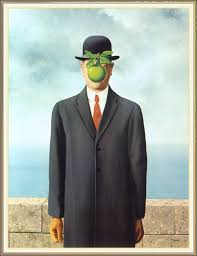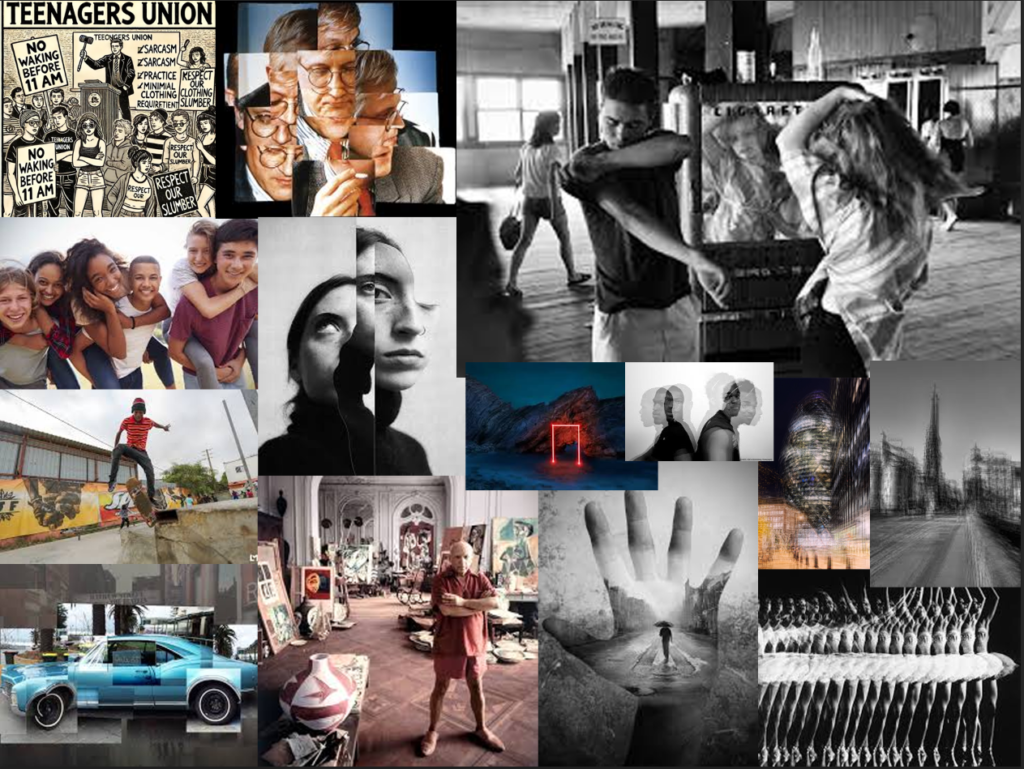Humanism (Humanist Photography)
What is humanism?
Humanism is a philosophical and ethical stance which emphasizes the value, dignity and agency of human beings. It is based around connectivity. It prioritizes reason, critical thinking and overall evidence over simple superstition which overall promotes the idea that humans can solve problems and improve the world through rational thought and cooperation.

What are the different types of humanism?
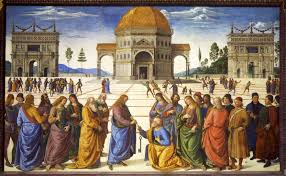
Renaissance humanism is a movement from the 14th-17th centuries that focused on reviving classical learning and literature.

Secular humanism is a modern perspective that rejects religious beliefs and emphasizes science, ethics and human rights.
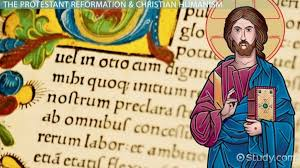
Religious humanism is a worldview that intergrades humanist principles with religious traditions, such as unitarian universalism, which is a liberal religious movement characterized by a “free and responsible search for truth and meaning”.
Union Link

Humanism in photography is about focusing on human connection,empathy and shared human experience. My project will explore emotional bonds through union. For example the unity of people through family,work or community.
Conclusion of humanism

At its core, humanism seeks to promote human welfare, progress, and fulfillment without relying on supernatural beliefs.
Artists to reference
Henri Cartier- Bresson
Who was he?
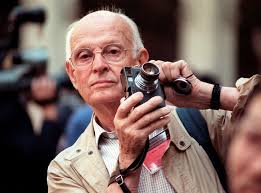
Henri Cartier-Bresson was a French artist and humanist photographer considered a master of candid photography, and an early user of 35mm film. He pioneered the genre of street photography, and viewed photography as capturing a decisive moment. Cartier-Bresson was one of the founding members of Magnum Photos in 1947.
The decisive moment
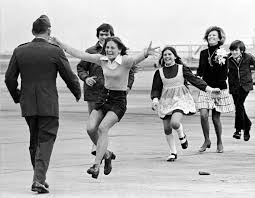
It refers to the precise instant when all the visual and emotional elements in a scene come together perfectly, creating a powerful and meaningful image. Cartier-Bresson described it as “the simultaneous recognition, in a fraction of a second, of the significance of an event as well as of a precise organization of forms.” This means that a photographer must anticipate action, composition, and emotion to capture a fleeting, yet impactful, moment.
How does he refer to Humanism?
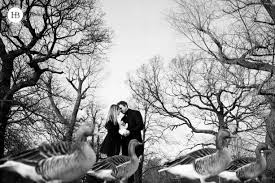
Henri Cartier-Bresson’s imagery is deeply connected to humanism, particularly humanist photography, which focuses on capturing the dignity, emotions, and everyday lives of people. His emphasis on the human condition, his photography often depicts ordinary people in moments of joy, struggle, contemplation or connection. His work highlights the universal aspects of human life, emphasizing these shared experiences of emotions throughout different cultures and societies.

His uses spontaneity and authenticity to reflect the humanist approach. The ideas of the decisive movement reflects his aim to capture life as it unfolds naturally, rather than staging or manipulating a scene, he tends to be very candid. This respects truth and individuality.

He shows a clear understanding of social awareness through his documentary work. Many of his images document history events and cultural movement, which offers insight into human struggles and triumphs. His work in war zones for example and daily life which reflects his humanist concern for social justice and awareness.

He proves to be non intrusive within his respectful approach. Unlike some photographers who might exploit their subjects his work shows a deep respect for human dignity. He personally believed in being an observer rather than an intruder, belding into the environment around him which enabled him to capture these authentic moments.
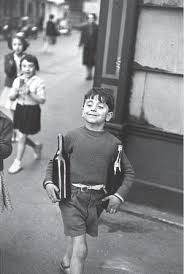
Henri travelled extensively whether it be across India and China or even the U.S, Europe and beyond, he managed to capture many diverse human experiences. His global outlook aligns with secular humanist ideals, which value cultural exchange, empathy and mainly a clear understanding across borders rather than post colonialism.
In conclusion his work is clearly a visual form of humans, it celebrated life, respects human dignity and captures the many universal emotions that connect people across cultures. His images can help remind us of the beauty,complexity and resilience of humanity.
Image analysis/focus

This is up there with some of his most famous decisive moments shots. This image capturers a an mid-air as he leaps over a puddle, being perfectly suspended in time. The photograph follows the rule of thirds, with the leaping man positioned slightly off-center, creating a clear dynamic tensions. This use of framing is subtle yet effective. The eye is naturally drawn to the man’s silhouette and the reflection in the water which mirrors his movement. The frozen movement allows for a sense of suspension and grace, showing beauty in what would normally be seen as an ordinary action. His reflection in the puddle adds symmetry and balance, which gives emphasis on the fleeting nature of the moment. This image is in black and white which enhanced the contrast between light and dark, the use of soft lighting and diffused shadows creates a surrealist atmosphere, feeling almost dreamlike. The fence and the urban elements in the background establish context and environment, creating a clear setting through the scene. With the use of the blurry industrial backdrop contrasting with the sharp silhouette it creates a very clear subject. The man’s leap may symbolize change, transition or even uncertainty as he is frozen in air before meeting the solid ground, Reality vs illusion, movement vs stillness.
How does this connect to humanism?
It represents the spontaneity and rhythm of life, showing an everyday person in an ordinary moment that becomes extraordinary through Cartier-Bresson’s lens. The wooden ladder in the water has been likely placed as a sort of makeshift bridge, which suggest improvisation and resilience, which are key themes central to humanism.
How does this connect to union?
It connects in many ways both visually and metaphorically. The image captures a perfect harmony between movement and stillness, therefore uniting the two realities into one frame. It can also be seen as a union of man and environment, where the man appears to be a part of the urban landscape blending in seamlessly reinforcing a humanistic connection to surroundings’. The action of leaping over water is universally relatable, creating an emotional connection with the viewer, speaking to shared human challenges. The elements of the image are arranged in a way that feels harmonious and interconnected, this acts as a visual bridge uniting the top and the bottom halves of the frame.
Surrealism
What is surrealism?
Surrealism is an artistic and literary movement that emerged in the 1920s, focusing on the irrational, dreamlike, and subconscious mind. It sought to break free from logic and realism, creating art that explored fantasy, dreams, and unexpected juxtapositions.
What are the different types of surrealism?
Dreamlike Imagery, inspired by Sigmund Freud’s theories of the unconscious, surrealist works often resemble hallucinations or dreams.
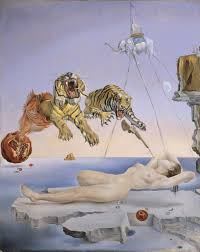
Unexpected Juxtapositions, artists combine unrelated objects or concepts in strange, thought-provoking ways.
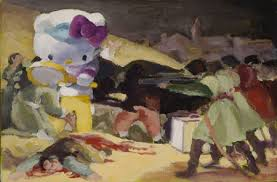
Automatism, a method where artists and writers create spontaneously, without conscious thought, to tap into the subconscious.
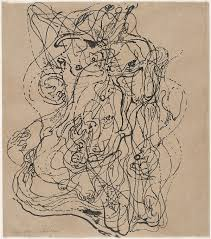
Irrationality & Absurdity, surrealism challenges logic and reason, embracing the bizarre and nonsensical.

Symbolism & Metaphor, objects often hold hidden meanings, reflecting deep psychological themes.
Conclusion of surrealism
Surrealism aims to revolutionise human experience. It balances a rational vision of life with one that asserts the power of the unconscious and dreams. The movement’s artists find magic and strange beauty in the unexpected and the uncanny, the disregarded and the unconventional.
Artist Reference
Man Ray
Who is he?

Man Ray was an American visual artist who spent most of his career in Paris. He was a significant contributor to the Dada and Surrealist movements, although his ties to each were informal. He produced major works in a variety of media but considered himself a painter above all.
What are the Dada and Surrealist movements?

Infamously called the “anti-art” art movement, Dadaism developed out of disgust and resentment from the bloodshed and horror of World War I, which began in 1914 and ended in 1918. Dadaism’s main purpose was to challenge the social norms of society, and purposefully make art that would shock, confuse, or outrage people.

Surrealism is an art and cultural movement that developed in Europe in the aftermath of World War I in which artists aimed to allow the unconscious mind to express itself, often resulting in the depiction of illogical or dreamlike scenes and ideas.
Conclusion of his work
Man Ray’s career is distinctive above all for the success he achieved in both the United States and Europe. First maturing in the center of American modernism in the 1910s, he made Paris his home in the 1920s and 1930s, and in the 1940s he crossed the Atlantic once again, spending periods in New York and Hollywood. His art spanned painting, sculpture, film, prints and poetry, and in his long career he worked in styles influenced by Cubism, Futurism, Dada and Surrealism. He also successfully navigated the worlds of commercial and fine art, and came to be a sought-after fashion photographer. He is perhaps most remembered for his photographs of the inter-war years, in particular the camera-less pictures he called ‘Rayographs’, but he always regarded himself first and foremost as a painter.
Image analysis/focus
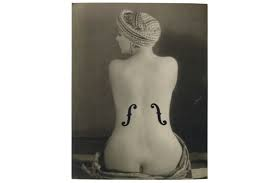
The subject and composition can be analysed as a nude woman with the suggestive silhouette and a violin in the shade of her back. The woman’s form is sculptural, where her human body is merely reduced to a form of a canvas which depicted woman as idealized forms. The violins shape is drawn in chalk like lines, which echoes his own studies of the human body. Integrating the elements of classical art with a dream like surrealist twist. The violin is an impotent symbol in his work, it alludes to the idea of an artists secondary passion or hobby. Ingres was known to be am accomplished violinist in addition to his work as a painter/photographer. Man Ray cleverly uses the violin as both a literally and symbolic device within the photo, offering a playful suggestion that the female body itself could be used as a musical instrument as well as an artwork. Some key surrealist elements are portrayed, as surrealist were fascinated by the juxtaposition of seemingly unrelatable objects. By placing the violin the image disrupts but also draws attention to the sexualised nature of the female form. The use of the violin is a playful distortion of familiar artists motifs, adding an element of absurdity. The lighting is also key to enhancing the from of the by rendering the violin as something almost unattainable , as if it is a abstraction. This brings attention to the objectification of the female form, using the instrument as a metaphor for desire. The models pose is reminiscent of the classical depictions of the female nude, whilst the violin makes it odd, almost unsettling. This ties into the early 20th century critiques of traditional arts treatment of woman as objects for male pleasure. The high contrast lighting emphasised the figure of the model, creating sharper shadow’s that accentuate the body’s form while drawing the viewers eye to the very exaggerated shape of the violin. The use of light here is reminiscent of Man Ray’s ,artery of experimental photography. Notably his famous use of rayographs and other methods that have explored shadow, texture and form. When this image was created in 1924 the surrealist movement was at its peak, pushing boundaries in both visual art and photography. Man Ray who was a prominent figure in the movement, experimented with both fine art and fashion photography, creating works that blurred the lines between the real and the imagined much like the surrealists approach to art and physiology.
In summary, Le Violon d’Ingres is a masterful blend of playful surrealism, art historical reference, and subversive critique of femininity, objectification, and classical art. It invites the viewer to reflect on the tension between the human form and the arbitrary imposition of artistic and sexual symbols. Through its light, composition, and humour, the photograph remains one of the most significant works in the history of 20th-century photography.
How does this connect to surrealism?
Ingres, whose name appears in the title of Man Ray’s photograph, was a leading figure of Neoclassicism, an art movement that can be seen as a continuation of the humanist tradition, where the human body was viewed as an ideal form to be studied and revered. In Le Violon d’Ingres, the model’s body is positioned in a similar way to Ingres’ classical nudes, suggesting a connection to this idealized human form.
The photograph emphasizes the human body, particularly through its curves, light, and shadows. This focus on the body itself evokes a humanistic tradition that places the human figure at the centre of artistic contemplation. However, the surreal manipulation of the figure with the violin inserted onto the model’s back introduces a surrealist twist to this tradition, creating both a nod to humanism and a challenge to its conventions. This tension between the classical ideal and the distortion of that ideal reflects a key theme of the early 20th century, when humanism was being re-examined, especially in light of modernity, industrialization, and the upheavals of war.
Hoe does this connect to union?
The most direct way the photograph connects to the idea of union is through the fusion of the human body with artistic representation. The model’s nude body, traditionally the subject of visual art, is combined with the violin, which is an instrument often used to create music, an entirely different form of art. This union of two distinct forms of art—visual and musical—creates a deeper connection between the body and the creative expression. The body itself becomes a medium through which both visual art (the photographic representation) and music (symbolized by the violin) are explored.
Man Ray’s photograph brings together two distinct artistic worlds: classical and surrealist. Ingres, the painter referenced by the title, was a master of classical art and Neoclassicism, which emphasizes idealized, often sensual depictions of the human body. Man Ray’s photograph invokes this classical aesthetic with the smooth, curvaceous form of the nude woman. However, by replacing her back with a violin, he injects a surreal, playful element that distorts this classical vision, bringing a modern, irrational twist to an otherwise conventional subject. This union of the classical with the surrealist approach reflects the way modern artists of the 20th century were blending historical traditions with experimental, avant-garde methods.
- How to Incorporate:
- Union Between Real and Imagined: Explore surreal or abstract depictions of unity. This could mean photographing individuals or objects that merge together in strange ways (e.g., using double exposure, juxtaposing dreamscapes with real scenes, or creating imaginary unions between people or elements in unexpected settings).
Pictorialism
What is Pictorialism?
Pictorialism was an artistic movement in photography that emerged in the late 19th century and flourished into the early 20th century. It was a reaction against the growing technical focus of photography, particularly with the rise of Kodak’s mass-market cameras, which made photography more accessible and mechanical. Pictorialism, in contrast, emphasized the idea that photography could be a fine art, comparable to painting or drawing.
What are the key elements?
Artistic Expression Over Technical Accuracy:

Pictorialists sought to move beyond the purely technical and documentary aspects of photography. They believed that photography should be an expression of artistic vision rather than just an accurate reproduction of reality. They often manipulated the image to create an emotional or aesthetic effect, mimicking the qualities of painting, such as soft focus, rich textures, and tonal effects.
Soft Focus and Painterly Effects:

One of the hallmarks of Pictorialist photography was the use of soft focus. Photographers would often intentionally blur the image or use techniques like gum bichromate printing or photogravure to create a texture that resembled a painting or etching. The result was a dreamlike, ethereal quality that emphasized mood over sharp detail. The soft-focus technique was meant to emphasize mood, atmosphere, and the emotional content of the scene rather than capturing the sharp, clear details associated with documentary photography.
Emphasis on Aesthetics:

Pictorialists were heavily concerned with the aesthetic value of their work, often seeking to create images that had emotional depth and conveyed a personal artistic statement. This approach was in direct opposition to the more straightforward, realistic style of photography promoted by photographers like George Eastman (founder of Kodak) and others who focused on the technical aspects of the medium. Pictorialists often chose to depict subjects in a more idealized or romanticized way, similar to how artists approached painting.
Influence of Impressionism and Symbolism:
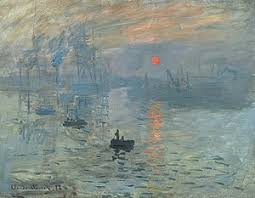
The Pictorialist movement was heavily influenced by artistic movements like Impressionism and Symbolism, both of which sought to evoke moods, feelings, and subjective experiences. Pictorialist photographers often sought to express emotion through their work, using techniques that were meant to evoke a sense of mystery, romanticism, or nostalgia. The use of light and shadow in a way that might be seen in Impressionist paintings became a hallmark of Pictorialism.
Conclusion of pictorialism
Pictorialism was an important early photographic movement that elevated photography to the status of fine art. It focused on creating mood, atmosphere, and personal expression through techniques like soft focus and manipulation of the print process. While it eventually gave way to more realistic, documentary styles of photography, Pictorialism helped establish photography as a legitimate art form and influenced generations of photographers to explore the emotional and creative potential of the medium.
Artist Reference
Alfred Stieglitz
Who Is He?

Alfred Stieglitz (1864–1946) was a pioneering American photographer, art dealer, and promoter who is widely regarded as one of the most influential figures in the history of photography. His work helped elevate photography to the status of fine art, and his efforts were key in the development of modern photography in the early 20th century. Stieglitz is often credited with helping to establish photography as a legitimate art form. At the time, photography was often seen merely as a technical or commercial pursuit, not as a form of creative expression comparable to painting or sculpture. Stieglitz worked tirelessly to change that perception and advocate for the artistic potential of photography. Pictorialism: Initially, Stieglitz was a proponent of Pictorialism, a photographic movement that emphasized the emotional, aesthetic, and artistic qualities of images over technical precision. He used soft-focus techniques, grain, and other methods to make photographs resemble paintings or prints, creating mood and texture. This helped elevate the medium as an art form.
What is the 291 gallery?
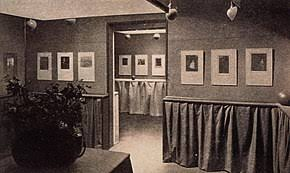
In 1905, Stieglitz opened Gallery 291 in New York, which became a significant space for exhibiting modern art, including photography, painting, and sculpture. The gallery was a pioneering venue that showcased European modernist painters (like Picasso and Matisse) as well as American artists. Stieglitz also displayed his own photographic work there. The gallery became an influential centre for avant-garde art and played a critical role in the development of modern art in America.
Conclusion of his work
Alfred Stieglitz was a visionary who played a foundational role in elevating photography to the realm of fine art. Through his work as a photographer, his founding of the Photo-Secession movement, and his gallery exhibitions, he changed the way people viewed photography and modern art. His contributions helped shape the artistic landscape of the 20th century, and his legacy continues to influence photographers and artists today.
Image analysis/focus
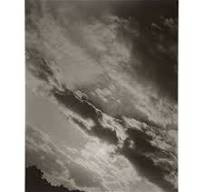
Stieglitz took a series of cloud photographs, which he referred to as “Equivalents.” These were abstract, poetic images that he viewed as visual representations of emotion, akin to musical compositions. This body of work marked a significant shift in his artistic approach, aligning him more with modernist ideals of photography.
The primary subject of the “Equivalents” series is clouds—Stieglitz photographed clouds in a way that abstracted them from their typical, literal interpretation. The images are close-up, largely devoid of recognizable details like sky or landscape, and instead focus purely on the clouds’ forms, textures, and tonal qualities. Stieglitz’s goal was to capture the emotional equivalence of a visual experience—hence the title “Equivalents.” The clouds become metaphors, intended to convey emotion, mood, or states of mind rather than depict any physical object or scene. Compositionally, these photographs often have sweeping curves and jagged, cloud-like formations that evoke a sense of movement. The use of space is essential to the abstract nature of the work. The photographs often frame the clouds against an empty background, isolating them and focusing the viewer’s attention on the cloud forms and their tonal variations. Light plays a crucial role in the “Equivalents.” Stieglitz was a master at controlling light exposure, and in these images, light is used to emphasize the texture and mood of the clouds .The photographs exhibit a wide tonal range, from deep blacks to pure whites, creating dramatic contrasts. This play of light and dark adds an emotional depth to the images, enhancing their abstraction and making them feel more like musical compositions or paintings than traditional photographs. Stieglitz described the “Equivalents” series as a way to express emotion through abstraction, much like music expresses emotion through sound without any literal representation. The use of clouds as a subject can be seen as an attempt to achieve something akin to musical equivalence in the visual world. Just as a composer might create emotional resonance through the arrangement of musical notes and rhythms, Stieglitz arranged visual elements of light, form, and tone to create an emotional experience. This parallel between music and photography was an important part of Stieglitz’s thinking. He believed that just as a musician does not depict a literal “sound” but instead creates an emotional tone, so too could photography convey emotion through its forms.
How does this link to pictorialism?
Alfred Stieglitz’s “Equivalents” series represents a departure from his earlier work as a Pictorialist photographer, yet it also carries traces of the Pictorialist influence.In the “Equivalents” series, although Stieglitz had moved toward a more modernist approach, some aspects of Pictorialism are still present. For example, the emotional resonance of the work and the focus on mood or atmosphere over objective realism still echo Pictorialist ideals. Stieglitz’s focus on the clouds’ forms and textures, the soft quality of the light, and the romantic abstraction could be seen as a continuation of Pictorialism’s emphasis on expressive aesthetics rather than strict documentary or technical precision.
How does this link to union?
Stieglitz’s “Equivalents” series, though abstract and focused on natural forms, can be seen as thematically linked to the concept of union in several ways. This connection is not immediately obvious in the literal sense, but it becomes apparent when considering the unification of emotion, nature, and the individual’s experience through the photographs. In the “Equivalents,” Stieglitz sought to capture the emotional essence of clouds, not as literal representations but as symbols of inner emotional states. The union of nature and emotion in this series is a key feature. Stieglitz felt that by photographing natural phenomena like clouds, he could evoke the emotional experiences of the human spirit, thus creating a union between the external world and the inner life.
- How to Incorporate:
- Symbolic Union: Create dream-like or idealized compositions that represent connections between nature and humanity, or between individuals in moments of tenderness, using soft focus and blurred edges to give a sense of unity.
Documentary Photography
What is documentary Photography?
Documentary photography is a genre of photography that aims to capture real-life events, environments, and individuals in a way that tells a story, conveys a message, or documents history. The key characteristic of documentary photography is that it focuses on truthful, objective representation rather than artistic manipulation. It seeks to provide an unembellished record of people, places, and situations, often with a social, political, or historical context.
What are some key concepts?
Realism and Authenticity
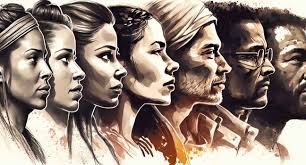
Documentary photography emphasizes a realistic and authentic representation of its subjects. Unlike staged or heavily edited photographs, documentary images aim to present the world as it is, often capturing moments that are fleeting or unplanned. The intention is to provide a truthful portrayal without manipulation or idealization. The goal is often to highlight real human conditions, social issues, or historical events, providing a raw, unfiltered glimpse into life.
Storytelling and Social Commentary

Documentary photography serves as a powerful tool for storytelling. It can be used to document significant events, everyday life, or aspects of society that are otherwise overlooked or ignored. Often, the photographs are meant to provoke thought, raise awareness, and sometimes even inspire social change by capturing moments that reveal injustices, inequalities, or the beauty of the human experience. For example, photojournalism is a form of documentary photography that focuses on documenting current events and news stories, aiming to inform the public about important issues.
Unposed and Candid

In documentary photography, the photographer often works in a candid manner, capturing subjects without them being aware or without posing. This approach helps to create a sense of naturalism, ensuring that the subjects are shown in their most authentic form. The focus is not on manipulating the subject’s appearance but rather on documenting their real-life context and the moment’s truth.
Artist Reference
Robert Frank
Who is he?
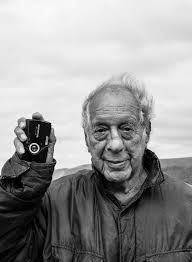
Robert Frank (1924–2019) was a Swiss-American photographer and filmmaker, widely regarded as one of the most influential figures in the history of documentary photography. He is best known for his ground-breaking work, particularly his book “The Americans” (1958), which is considered one of the most important photographic works of the 20th century.
What is the Americans?
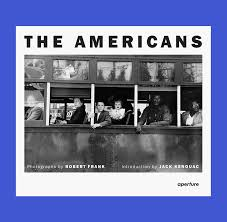
“The Americans” is Robert Frank’s most famous work, a collection of photographs taken during his road trip across the United States in 1955–1956. The book includes 83 images that depict the diversity and complexities of American life, from the rich to the poor, from everyday scenes to the marginalized. His style in “The Americans” was raw and uncompromising, capturing unsentimental and sometimes uncomfortable realities of American society. He did not shy away from showing alienation, inequality, and discontent, which contrasted with the idealized representations of America often seen in the media at the time. The book was initially met with some criticism for its unorthodox style, but it later became a landmark in the history of photography. It challenged the traditional aesthetics of the time and is credited with transforming documentary photography into a medium for personal expression.
Robert Frank’s work is fundamentally tied to documentary photography, as he played a crucial role in reshaping the genre and pushing it beyond its traditional boundaries.
- How to Incorporate:
- Documenting Union: Capture the collective identity of groups, whether they are families, labor unions, or cultural communities, showing how people come together in moments of shared purpose or adversity.






















